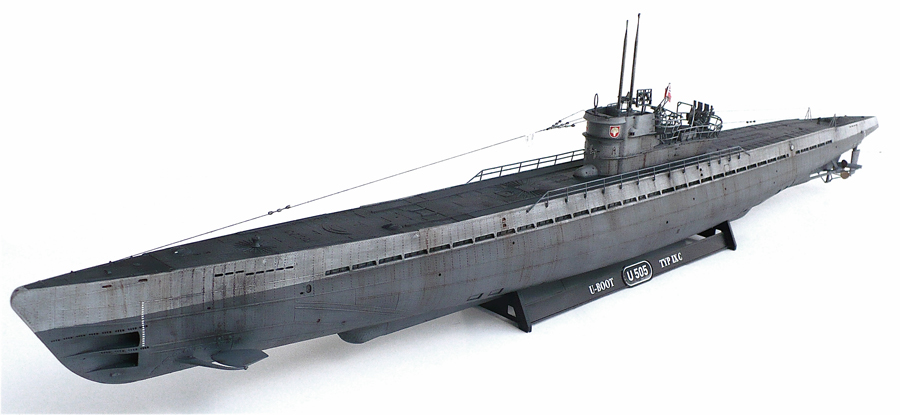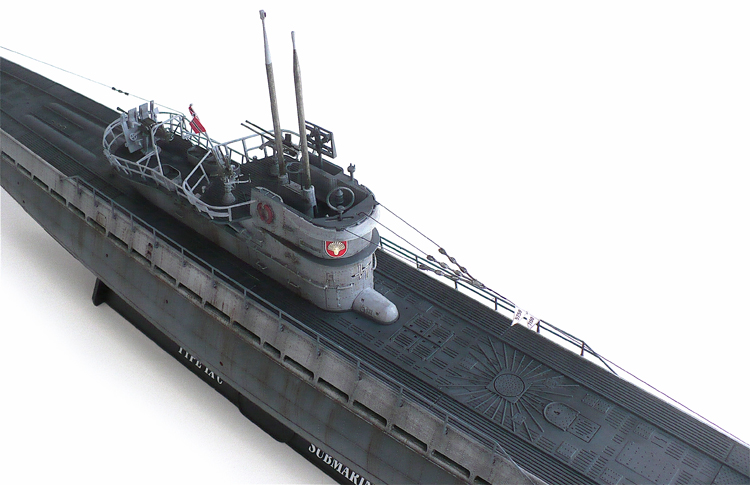Here are some images of Revell's 1/72 scale U-Boot Typ IX C (505) Late.
From Wikipedia"
The Type IX U-boat was designed by Germany in 1935 and 1936 as a large ocean-going submarine
for sustained operations far from the home support facilities. Type IX
boats were briefly used for patrols off the eastern United States in an
attempt to disrupt the stream of troops and supplies bound for Europe.
The extended range came at the cost of longer dive times and decreased
maneuverability, which is why the smaller Type VII was produced in greater numbers and used for the bulk of operations. It was derived from the Type IA, and appeared in various sub-types.
Type IXs had six torpedo tubes; four at the bow and two at the stern.
They carried six reloads internally and had five external torpedo
containers (three at the stern and two at the bow) which stored ten
additional torpedoes. The total of 22 torpedoes allowed U-boat
commanders to follow a convoy and strike night after night. As
mine-layers they could carry 44 TMA or 66 TMB mines, but many of the IXC boats were not fitted for mine operations.
Secondary armament was provided by one large Utof 105/45 gun with
about 110 rounds. Anti-aircraft armament differed throughout the war.
They had two periscopes in the tower. Types IXA and IXB had an
additional periscope in the control room, which was removed in Type IXC
and afterward.
Type IXC was a further refinement of the class with storage for an
additional 43 tonnes of fuel, increasing the boat's range. This series
omitted the control room periscope leaving the boats with two tower
scopes.
As mine-layers they could carry 44 TMA or 66 TMB mines, though U-162 through U-170 and U-505 through U-550 (35 boats), were not fitted for mine operations.
One IXC carries the distinction of being the only U-boat sunk in the Gulf of Mexico, U-166.
U-505 survives at the Museum of Science and Industry in Chicago, and as of 2005 has been completely renovated.
U-505 is a German Type IXC U-boat built for service in the Kriegsmarine during World War II. She was captured on 4 June 1944 by United States Navy Task Group 22.3 (TG 22.3). Her codebooks, Enigma machine and other secret materials found on board assisted Allied code breaking operations.
All but one of U-505's crew were rescued by the Navy task group. The submarine was towed to Bermuda in secret and her crew was interned at a US prisoner of war camp where they were denied access to International Red Cross visits. The Navy classified the capture as top secret and prevented its discovery by the Germans.
In 1954, U-505 was donated to the Museum of Science and Industry in Chicago, Illinois and is now a museum ship.
She is one of six U-boats that were captured by Allied forces during
World War II, and the first warship to be captured by U.S. forces on the
high seas since the War of 1812. In her uniquely unlucky career with the Kriegsmarine,
she also had the distinction of being the "most heavily damaged U-boat
to successfully return to port" in World War II (on her fourth patrol)
and the only submarine in which a commanding officer took his own life in combat conditions (on her tenth patrol, following six botched patrols). U-505
is one of four German World War II U-boats that survive as museum
ships, and one of two Type IXCs still in existence, the other being U-534.
After the war, the Navy had no further use for U-505. She had been thoroughly examined in Bermuda, and was now moored derelict at the Portsmouth Navy Yard. It was decided to use her as a target for gunnery and torpedo practice until she sank.In 1946, Gallery, now a rear admiral, told his brother Father John
Gallery about this plan. Father John contacted President Lenox Lohr of
Chicago's Museum of Science and Industry (MSI) to see if they would be
interested in U-505. MSI, established by Chicago businessman Julius Rosenwald,
was a center for "industrial enlightenment" and public science
education, specializing in interactive exhibits. As the museum already
planned to display a submarine, the acquisition of U-505 seemed ideal. In September 1954, U-505
was donated to Chicago by the U.S. government, a public subscription
among Chicago residents raised $250,000 for transporting and installing
the boat. The vessel was towed by United States Coast Guard tugs and cutters through the Great Lakes, making a stop in Detroit, Michigan in the summer of 1954. On 25 September 1954, U-505 was dedicated as a permanent exhibit and a war memorial to all the sailors who lost their lives in the two Battles of the Atlantic.
When U-505 was donated to the Museum, she had been sitting
neglected at the Portsmouth Navy Yard for nearly ten years; just about
every removable part had been stripped from her interior. She was in no
condition to serve as an exhibit.
Admiral Gallery proposed a possible solution. At his suggestion, Lohr contacted the German manufacturers who had supplied U-505's original components and parts, asking for replacements. As the Admiral reported in his autobiography, Eight Bells and All's Well,
to his and the museum's surprise, every company supplied the requested
parts without charge. Most included letters that said in effect, "We are
sorry that you have our U-boat, but since she's going to be there for
many years, we want her to be a credit to German technology."
In 1989, U-505 was designated a National Historic Landmark. When the U.S. Navy demolished its Arctic Submarine Laboratory in Point Loma, California in 2003, U-505's
original observation periscope was discovered. Before the submarine was
donated to the MSI, the periscope had been removed from U-505
and placed in a water tank used for research. After being recovered, the
periscope was given to the museum to be displayed along with the
submarine.
By 2004, the U-boat's exterior had suffered noticeable damage from
the weather; so in April 2004, the museum moved the U-boat to a new
underground, covered, climate-controlled location. Now protected from
the elements, the restored U-505 reopened to the public on 5 June 2005.







3 comments:
Wow! Really nice weathering !!!
Thanks Manchu!!
My cat Squishy approves of your cat Inky's approval.
https://lh5.googleusercontent.com/-X-mbkDfveeE/U8oGuz8S7TI/AAAAAAAAZTg/mnZ5-ZGo3Kg/w1024-h768-no/squishy+5.jpg
Post a Comment